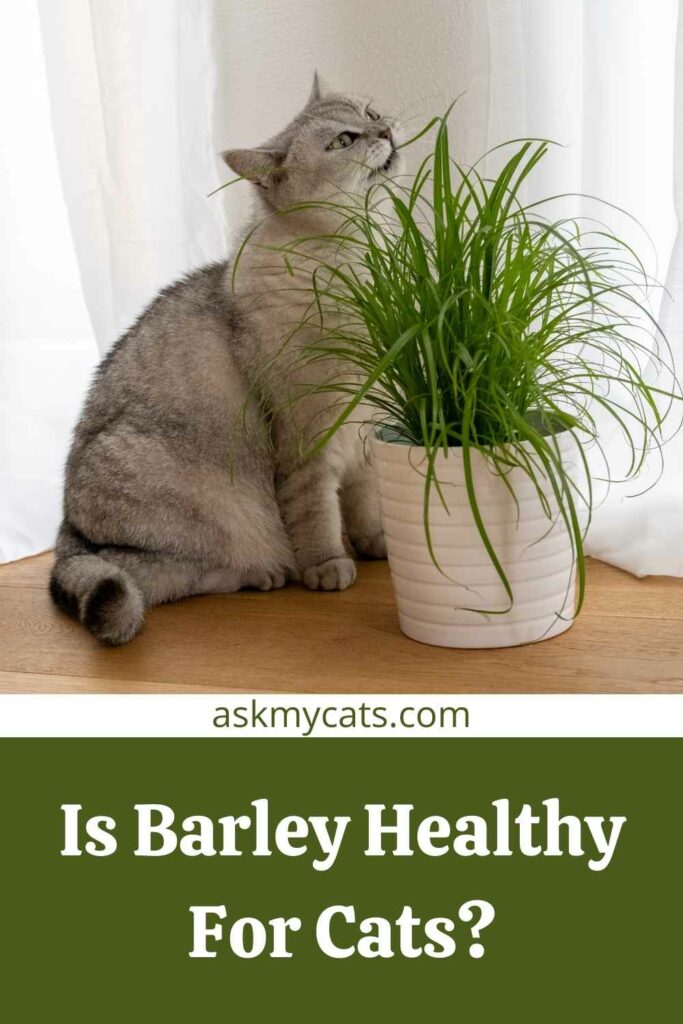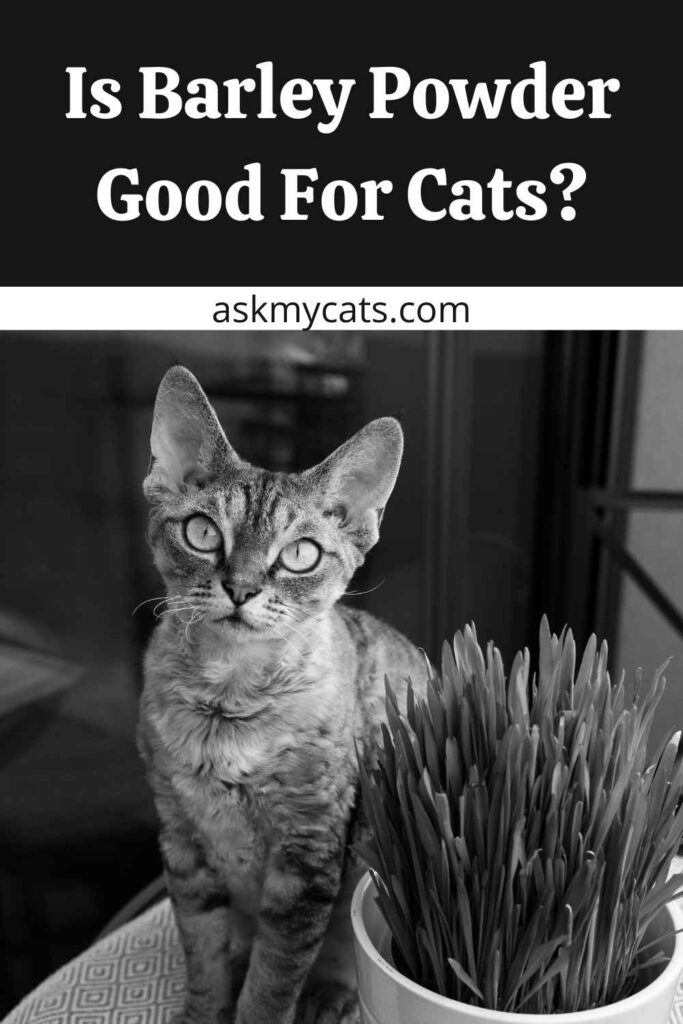Fresh green grass, which is high in vitamins, minerals, and enzymes, is eaten by cats intuitively. That same grass, on the other hand, is laden with pesticides and artificial fertilizers that are potentially detrimental to their health.
For your cat, barley sprouts are an excellent source of fiber and nutrients. Cats not only like these delicious, delicate greens, but they also benefit from them! Barley greens are a digestive aid that also helps to avoid hairballs. You shouldn’t be alarmed if your cat regurgitates after eating barley grass on occasion.
Another disadvantage of eating entire grass is that each blade has tiny barbs that can irritate the stomach and throat. Barley grass powder is excellent for your cat – and your carpet – since it is made with just fresh juice and no barbs.


Give Your Cat the Perfect Day
Get the Free Ebook!
Is Barley Healthy For Cats?
Barley is healthy for cats and there are merely any side effects of eating barley.

After all dangers of frost have passed, you may plant cat grass straight in the garden. Barley isn’t picky about the soil it grows on, although it does appreciate full light. It will reach three or four feet in height in approximately 60 days and be ready to harvest.
Barley, often known as cat grass, maybe a beautiful houseplant as well as a nutritional treat for your cat all year. Cat grass when included in a balanced diet may help your cat become healthier and more comfortable.
Your cat will be a “cool cat” for sure. A “cool cat,” as the term was used in the 1920s, was someone who was current on all the newest trends and music.
Certain sizes and textures of food appeal to cats. Rice is OK in modest amounts, but other grains such as oats, barley, and whole-wheat breadcrumbs may be preferable. Smaller chunks are easier for cats to digest and have greater nutritional value.
Purchase “cat” grass or grow your own at home. Wheat, barley, and oat grass are all tasty to cats, who consume them for one of two reasons, scientists say.
They do it either to satisfy an oral fixation or to protect themselves from intestinal parasites. My cat can eat a container of cat grass in a day (until he becomes unwell), so we now keep track of his intake and remove it after a few minutes.
If your cat is ready to eat vegetables, experts agree that feeding them a few nibbles every now and again isn’t harmful. Steamed broccoli and other greens are a favorite of certain cats!
Never give a cat anything from the onion family, green tomatoes, or raw potatoes; instead, stick to green leafy vegetables like carrots.
To avoid choking, make sure the vegetables are clean, soft (cooked), and tiny enough; a cat’s teeth are intended to break apart meat, not bite on crisp vegetables.
Cats, although being carnivores, can digest grains. They, like people, should be given entire grains rather than processed grains. This should be a rare treat (no more than a tablespoon), and the grains should be devoid of spices and additional fats.
Cats should only consume cat food and nothing else. Overfeeding, according to experts, is the most serious problem confronting animals today; our pets are growing as fast as we are and developing many of the obesity-related illnesses that plague us.
Any “extras” might have a negative impact on your pet’s weight. Treats, whether homemade or purchased, should account for no more than 10% of your cat’s daily calorie intake (31 calories for a 12-pound cat).
You might also like to know the difference between cat grass vs wheatgrass
Is Barley Powder Good For Cats?
Yes, barley powder is good for cats to eat.

Cats love fresh green grass intuitively since it’s high in vitamins, minerals, and enzymes. However, there are microscopic barbs in grass that can cause stomach and throat discomfort, as well as the possibility of exposure to pesticides or fertilizers.
Barley powder is healthy for both your pet and your carpets because it is prepared from fresh juice without the barbs.
Barley grass powder is high in active enzymes, which are often lacking in today’s manufactured cat diets, so sprinkling some on your pet’s food will not only improve the taste but will also allow for better nutritional absorption.
The key benefits of barley powder are:
- Active enzymes, vitamins C and E, beta-carotene, amino acids, chlorophyll, bioflavonoids, and trace minerals are all present.
- Sprinkle it on processed cat food to increase flavor and nutritional absorption.
- The regular application promotes healthy skin and coat, eliminates bad breath, improves digestion, and replenishes energy levels.
- Taurine, an amino acid that cats cannot synthesize on their own, is also present, and it aids in the maintenance of good vision and cardiac function.
- It provides the health advantages of eating grass without causing digestive discomfort or exposing you to potentially hazardous chemicals.
Is Barley Porridge Good For Cats?
Yes, barley porridge is good to be served to cats.
The main advantage of serving barley porridge to your cat is that it acts as an antibacterial agent and can be provided to your cat with fine choppings of meat. It is not needed to add any special spices except salt when cooking the porridge.
Barley porridge also actively cleans the digestive tract. Moreover, it also contains substances necessary for maintaining health such as vitamins A, B, and D and amino acids which helps to prevent allergic reactions, iodine, and phosphorus.
Also, check out details about cat grass vs catnip
Can Cats Eat Cooked Barley?
Yes, cats can eat boiled or cooked barley.
Can Cats Eat Barley Grass?
Barley grass can be a nutritional food for your cat.
Cats enjoy barley grass, which is high in vitamins, minerals, and enzymes. It has a long history of being safe and simple to grow to be one of the earliest cultivated grains.
It’s extremely resilient and can grow to be 14 inches long! When designing your garden, consider combining three types of grass.
If you observe your indoor-outdoor kitty grazing in the yard or garden on a frequent basis, you should consider planting cat grass indoors or in a catio.
Cat grass is a far safer option than outside grass and plants that may have been treated with weed killers, fertilizer, or pest control chemicals.
And, although pet-friendly versions of those things are available, you may as well give him a (safe) taste of the great outdoors no matter where he is!
Also, check out alfalfa grass for cats
How Do You Plant Barley Grass For Cats?
- Fill your container to around 3 to 5cm from the top with dirt.
- Before distributing the seeds uniformly throughout the soil’s surface, moisten it.
- When you’re finished, loosely wrap the seeds with cling wrap.
- Keep the container in a cool, dry place away from direct sunlight.
- The seeds should begin to germinate after 3 to 7 days. Remove the plastic lid and place the container in a well-lit area.
- After 10 to 14 days, your grass will be suitable for ingestion for your feline companion.
- Replace your grass when it starts to wilt, which generally happens after a few weeks.
Is Wheat Grass And Barley The Same?
No, wheat grass and barley are different types of cat grasses.
Wheatgrass has a plethora of minerals, vitamins, and amino acids. It is not only beneficial for your cat, but it may also help you if you include it in your diet.
Barley grass is a sweet, delicate green that is high in nutrients and an excellent source of fiber.
Check out more details about Can Cats Eat Wheatgrass? Is Wheatgrass Good For Cats?
Is Cat Grass The Same As Barley?
No, cat grass is not the same as barley.
Dactylis glomerata is the scientific name for the grass, which is popularly known as cocksfoot or orchard grass. This grass is popular with cats and other animals due to its high sugar content.
There are no nutritional benefits to feeding your cat homegrown cat grass or grass from the outside. They usually vomit it up again or the next day. As a result, they do not consume enough to get those benefits.
Cat grass and wheatgrass are not interchangeable. Triticum Aestivum is found in wheatgrass (common wheat). Dactylis Glomerata is found in cat grass (cocksfoot or orchard grass.)
Frequently Asked Questions
How long does it take to grow cat grass?
It takes 10 to 14 days for cat grass to flourish. Keep the seeds moist but not saturated in the soil during germination. The grass seeds take 3 to 7 days to germinate. Your cat grass should keep at a height of 4 inches and last for 1 to 3 weeks.
Why do cats eat grass to make themselves sick?
Cats don’t eat grass to get sick, but they do so because they lack the enzymes required to digest a big amount of grass. It’s beneficial for your cats to eat grass since it helps to cleanse their stomachs of anything that could irritate their digestive system.
Do indoor cats need grass?
Cats don’t need to eat grass, and it isn’t required, but it is a good idea to allow your cat eats grass and have some on hand every now and then to aid with digestion.
Final Words
Grain-free diets are beneficial for cats with sensitive skin and intolerances, as grains such as maize, rice, barley, and wheat have been linked to allergies and can cause a variety of issues with a cat’s skin, hair, and digestion.
Please leave your questions about your pet friend’s feeding habits in the comments section below. We’ll get back to you as soon as possible.
Also, check out Oat Grass For Cats: Is Oat Grass Good For Cats?
